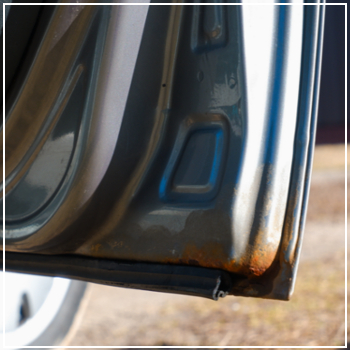Top Spots for Rust on Your Car
 When rust goes unchecked, it can lead to serious structural problems, compromising the vehicle's frame and safety features in case of an accident.
When rust goes unchecked, it can lead to serious structural problems, compromising the vehicle's frame and safety features in case of an accident.
Rust typically develops when exposed metal comes into contact with moisture and salt, causing a chemical reaction. Vehicles made from materials other than galvanized steel or aluminum are more susceptible to rusting. Coastal areas with warm climates and regions that frequently see snowfall can accelerate the rusting process.
Where Does Rust Begin?
Rust often begins forming on the underside of the car, especially after driving on salt-treated roads. However, it can start anywhere, so it's important to conduct a thorough inspection and consult a professional to address any visible rust spots, peeling paint or bubbling surfaces.
These signs suggest that rust might be affecting the underlying metal. Be sure to examine these key areas carefully.
Frame Rails
The frame rails run along the sides of the vehicle, just beneath the doors. They're prone to rust because they're close to the ground and constantly exposed to the elements. Cars usually use thinner, lower-gauge steel in this area, which makes them more vulnerable. Ignoring rust in this part can allow it to spread throughout the vehicle, leading to expensive repairs later on.
Wheel Wells
Located directly above your tires, wheel wells are highly exposed to corrosive substances like rock salt during winter and often accumulate moisture and debris throughout the year. The metal used in wheel wells tends to be thinner, making it more susceptible to rust. Perform a visual check first, then feel along the interior with your hand to confirm any issues.
Exhaust System
Since the bottom of the car is more exposed to environmental factors and rock salt, it's more prone to rusting. The exhaust system, particularly the tailpipe, is especially vulnerable to both internal and external moisture, as well as the buildup of mud and debris. Additionally, the materials comprising the exhaust system—such as stainless and cold-rolled steel—are more prone to rusting. Beyond checking the tailpipe, inspect areas where the system bends or connects, including the muffler and catalytic converter. A rusting exhaust system can affect the car's ability to manage emissions and may even redirect harmful gases like carbon monoxide into the cabin.
Rocker and Quarter Panels
Rocker panels and the lower rear quarter panels sit near the base of the car. These areas are not only highly exposed to the elements but also to road debris, moisture, and rock salt. Chipped paint is more common in this region, exposing the metal underneath and inviting rust to form. Inspect both the inside and outside of these panels for signs of rust.
Floors
We seldom lift the carpeting in our vehicles, but rust can start or worsen here. Remove the floor mats and check around the insulation within the car's cabin. Don’t forget to inspect the trunk and remove the carpet to examine the area around the spare tire.
Doors
Rust can begin on doors due to chipped paint, accumulated debris, or moisture trapped in the drain holes. It may also spread from nearby panels or the suspension system. Inspect both the inside and outside of the doors for rust patches and ensure the drain holes are cleaned out regularly.
The Engine Bay
Most engine components experience only surface rust, which rarely affects their functionality. However, if you're buying an older vehicle with fewer plastic components, it's wise to check under the hood for rust on the exhaust manifold, alternator, and strut tower.
Fenders
Newer vehicles often use plastic for the inner fender, limiting the spread of rust. However, the outer fender, made of two welded or bolted sheets of metal, can still develop rust, especially in older cars. Although this area is less likely to show visible signs of rust, it can trap debris and moisture.
Suspension
The suspension system includes several metal parts that support the vehicle. Rust here isn't just cosmetic—it can quickly become structural once it spreads. Pay close attention to the shocks and struts, control arms, ladder frame, and any parts connected by bolts.
If you're worried about rust, the experts at DaSilva’s Auto Body can help by inspecting your vehicle and applying rustproofing treatments before corrosion takes hold. For more information, reach out to our Naugatuck location today.
Metal Ink is a versatile and durable ink designed for use on metal surfaces. It is commonly used in a variety of applications including screen printing on metal. Metal Screen Printing Ink are specially formulated to adhere to metal surfaces and provide long-lasting, vibrant color.
When screen printing on metal, using the right type of ink is crucial to achieving high-quality results. Metal ink are designed to withstand the unique challenges of metal printing, such as adhesion and durability. It's formulated to bond effectively to metal surfaces, ensuring printed designs remain intact and vibrant over time.
Metallic Screen Printing Ink,Gold Ink Printing,Metallic Gold Screen Printing Ink,Glitter Ink,Ink For Aluminum Sheet
Lauer Water-Based New Material(Foshan)Co.,Ltd. , https://www.lauerink.com